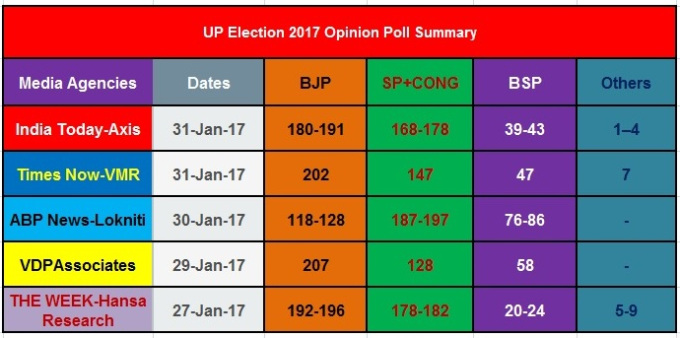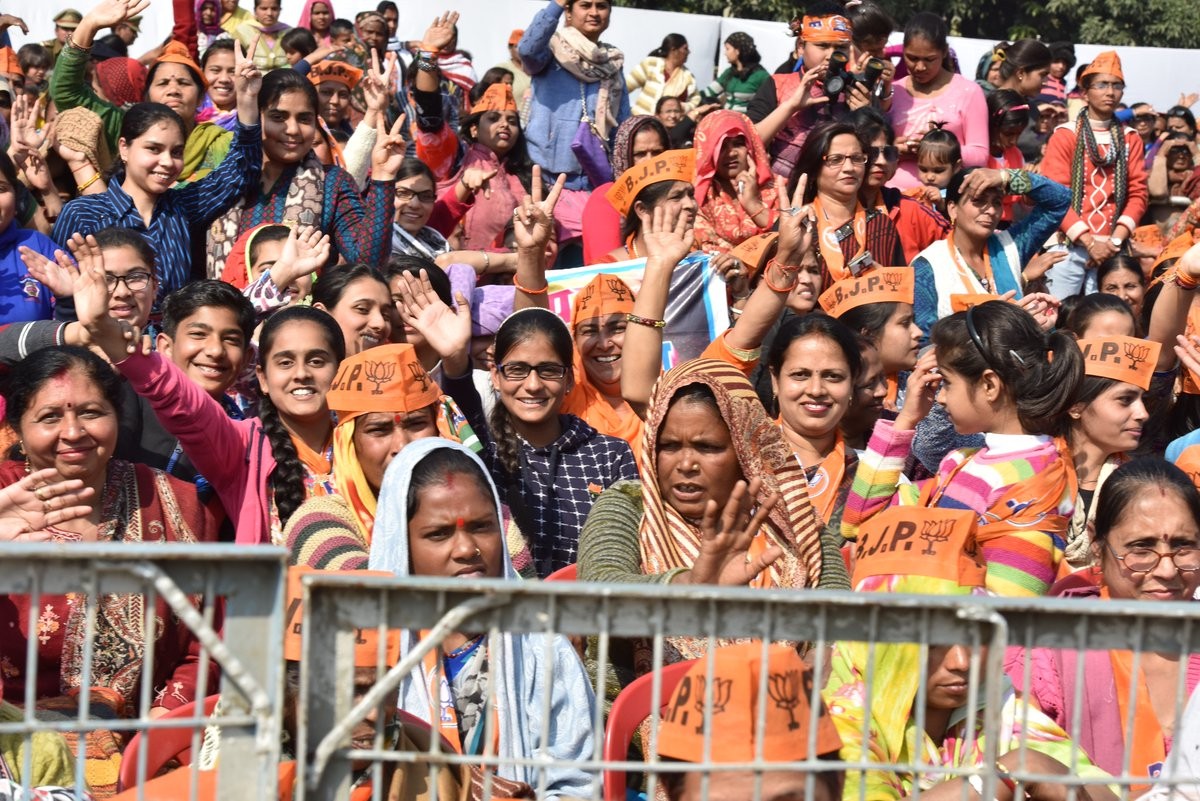The BJP could spring a surprise in Uttar Pradesh
- In Politics
- 01:16 PM, Feb 13, 2017
- Shwetank Bhushan
The most populous state in India, with a population of over 200 million people, if Uttar Pradesh (UP) were an independent country it would be world's sixth largest country in terms of population.
As UP prepares to elect its Assembly, it reminds us of a famous saying that the political road to Delhi goes via Lucknow. In 2014, Narendra Modi reconfirmed it with a slight change, by boarding at Benaras.
THE MOOD IN UP:
In UP, over the past two years at least, the demand for change at the state level also is loud and glaring. From 1967 to 2013 the general trend in UP has been that voters have swerved in one direction to vote out a government. It is most likely to be the same in 2017. The only challenge that may stand in Modi/BJP's path is the electoral complexities of UP.
There is a great anti-incumbency against the Samajwadi Party which the mastermind Mulayam Singh Yadav tried to break and smoothly pass the baton to Akhilesh (reconfirmed by Amar Singh 'Bahri' in his latest Aap Ki Adalat interview) in a single move of an orchestrated family squabble.
The pragmatic Indian voters in the Hindi heartland no longer embrace the old culture of doles and handouts before elections, hence the budget was remotely populist. The backdrop of this was the whopping 1.25 Lakh Crore package in Bihar by Modi that lost to a simplistic reservation plank and Mr. Modi now understands that.
MEDIA NARRATIVES AND CRITICAL ISSUES:
The localized political factors have always trounced the media narrative especially the Lutyens Delhi variety. The most important issues for UP voters are power cuts, crime, and safety, economic development, jobs, water shortages, transport and roads, corruption, schools, health, hospitals and agriculture related.
Giving credence to the Lutyens media that an overtly pro-Hindu sloganeering can spoil the mood for change, suggests no understanding of the ground realities. The issues like "love jihad" and proposed 'ban on slaughterhouses' are real local matters and are gaining traction in Western UP which the mainstream media hates to address.
Demonetization (note-bandi in the local dialect) will not be the critical issue, but any failure by the BJP to become the single largest party will be claimed as a vote against note-bandi. It's a good thing that this myth is also likely to be busted after UP Poll that people are extremely angry about note-bandi.
This is how the narrative of "anger against Modi" is being centrally orchestrated through the editorial class of Delhi. For them lies become theories, theories become narrative and narrative becomes the reality which voters are going to respond to, only in their fantasies. Most media entity and the fraud pollsters in and around Delhi hopefully believe that the Akhilesh+Rahul partnership is sweeping UP.
NOTE-BANDI:
When PM Modi announced demonetization, he was repaying that faith of his voters. The survey shows that note-bandi has a positive impact on BJP's vote-share. Note-bandi came on November 8, 2016, but the present survey shows the BJP's vote share increasing from before that period. Those who were with Modi in 2014 are ardent supporters of note-bandi too, and those who stood against Modi are more or less against his note-bandi measure too. The biggest impact of note-bandi in UP election is that it has taken a toll on politicians and forcing them to spend miserly this election season.
KEY COMPLEXITIES:
No electoral story in UP is complete without the complexities of religious and caste configurations. While development may be on top of the mind, at the core of UP electoral math is the caste narrative construct. Here is the broad caste-matrix and the statistics for the state:
Muslims – 19.5%, Yadavs – 9%, Other than Yadav OBCs – 27.5% (including baniyas), Dalits – 22%, Thakurs – 8%, Brahmins – 13%, Jats-2%.
It is evident from the data that the Muslims and other OBCs are key segments. BJP's success depends on Shah's smart micro management of the backward caste while managing to hold on to the upper caste votes. Brahmins are a crucial section of voters who constitute nearly about 12-13 percent of the total electorate of the state and them returning to the BJP is a huge setback to Behan Mayawati.
Dalits look at SP as their main enemy and usually consolidate against Mulayam's party, so this time too sensing that BJP is in the pole position to defeat SP, a large section of non-Jatav Dalits is voting for the saffron outfit. If it can wean away the non-Jatav Dalits from BSP, it will again convert the edge to a wave.
There is also a new generation of voters too, which is fed up with the gross misrule and proved in 2014 to be potentially cutting across the caste lines, and decide the fortunes of BJP.
THE MUSLIM FACTOR:
Muslims comprise 19 plus percent and play a decisive role in almost 120 constituencies of UP. With the recent riots in Muzaffarnagar, Dadri incident and also the Love-Jihad plank, SP is hoping to benefit if the Muslim votes get polarized. Akhilesh with now Mulayam backing him should be able to hold a bigger chunk, but their overall vote share may decline. Some sections of the community (especially the Pasmanda Muslims) are upset with SP because of the inability of the state govt to control the situation and bring relief to the victims.
The criticality of the community can be understood from the fact that Mayawati has fielded 97 Muslim candidates this time. But politicians do politics, while Muslims make the strategy. Most Muslims will vote tactically for that candidate or party, who would defeat BJP. The Muslim vote is unlikely to be split because of the SP-Congress alliance.
THE SHAH MATRIX:
Amit Shah's role in UP is likely to make (or break) a kind of politics that is being blamed, but he is unruffled. While Modi, in rally after rally, is selling the dream of development, Amit Shah is mobilizing the RSS/BJP cadre to hold the Modi-sympathizers to the booths.
Development as prime agenda and subtle Hindutva as the undercurrent is probably the best electoral template for BJP in the Hindi-heartland.
5Forty3 in its latest survey also talks about it in details. The one thing that I am in complete agreement with Dr. Patil's observation is that Amit Shah is making the ‘Shekhawat doctrine' as its key political strategy.
As per this new strategy, the Ram temple is apparently no longer the sole Hindutva agenda and greater emphasis is given to various sub-regional concerns of core voters like the "anti-Romeo squads" and the ‘ban slaughterhouses.'
It also focuses on the incorporation of non-Yadav OBCs and is -Jatav Dalits. Shah is taking this doctrine to even greater heights by allocating 150 seats to non-Yadav OBCs. This time BJP has awarded 100+ seats to new entrants based on sound electoral engineering that brings additional localized strength to the party. This has caused some discomfort to the loyal old-timers (and also the RSS cadre). But the fact is they have failed to win elections in past.
LEADERSHIP AND ALLIANCE:
BJP had two-and-a-half years to find itself a local leader, but it's a pity that it is leaderless in such a vital state that may cost them a little. But BJP is gambling on Modi's popularity galvanizing the backward class and the youth looking for hope. PM Modi's grip on BJP supporters is unchallenged. The turnout at Modi's rally in UP are truly gargantuan, full of mostly non-Yadav OBCs and non-Jatav Dalits; and the hope and courage in their eyes are evident. "ना जात पे ना पात पे, मोदी जी की बात पे" (neither caste nor creed, we only trust Modi
"ना जात पे ना पात पे, मोदी जी की बात पे" (neither caste nor creed, we only trust Modi Ji) is the new mantra spreading in rural UP. If the prevailing conditions continue, Modi can win a sizeable chunk of votes based on his personality, his background, and people's non-fading expectations.
Akhilesh Yadav's attempted image reinvention as a young Chief Minister breaking away from his party's past and presenting a suave face of development may have come a little late. Unlike Nitish Kumar, Akhilesh is unable to make that big transition.
Akhilesh has won the confrontation with his father in media but the fact that the bulk of the SP cadre is aligning with him brings back the Mulayam baggage where crime and the prevailing law and order situation because of political patronage is considered to be a major concern in the state.
The last minute alliance with the Congress allowed Akhilesh-Rahul a shortened campaign but enhances the anti-incumbency bringing Congress's past records. The fact that Akhilesh gave away 105 seats to Congress (only in the hope that Muslim votes do not wither) which is not capable of winning more than ten seats in UP today, has not gone down well with many local SP leaders, especially those who have lost out on an opportunity to contest. Congress is hoping to be the biggest gainer, as it may get seats much more than it is individually capable of winning.
NUMBERS AND OPINION POLLS:
People don't want to give away which party they support. Therefore, they say that they are undecided. Though most voter make-up their mind much before the election, but change their mind only if anything very critical happens.
In 2014 LS elections, the BJP had won 81 percent of 403 seats with a whopping 44% vote share, and only a massive shift of loyalties can cause BJP lose in the 2017 state assembly election. A bigger problem for Akhilesh is that in 75 seats it won with a margin of below 5% or 5-10% in 2012. These are obviously vulnerable constituencies.
Most of the opinion pollsters are giving BJP an edge over SP-Congress alliance and are explicitly calling BSP a distant third, but no one saying precisely who is winning UP state assembly election.

UP Election 2017 Opinion Poll Summary
PHASED ELECTION IMPACT:
The election in the state is in seven phases, which started on 11 February, from the western region. Voters do shift and decide whom to support based on which party they perceive have greater support in the first few phases. We saw this disproportionate influence in 2015 Bihar Assembly election.
For the Samajwadi Party, this is possibly their weakest region. In UP the western part is going to vote overwhelmingly for BJP as a result of major polarization. The trend of the first phase is already a talking point. Even traditional Mayawati voters are said to be choosing BJP in sufficiently large numbers to send alarm bells in the BSP camp.
Another big reason for the BJP's confidence is the support from the Jats who have traditionally backed Ajit Singh's RLD, had swung BJP's way in 2014 and still supports them overwhelmingly.
It must also be noticed that whenever there has been high voter-turnout in this belt, BJP has done extremely well. This time too with 64.5% voting in the first phase may spell doom to SP once again.
CONCLUSION:
Various opinion polls indicate leads and are projecting that the BJP will get the maximum number of seats, but all are shying from giving BJP a clear majority. With Modi's popularity, strengthened by Shah's matrix and anti-incumbency against SP on the other side, complemented by lead in the first couple of phases, this is leading to a wave. The ability and strength of a wave are to overcome obstacles and spread out into unforeseen territories.
If my understanding is right, there is a realm of possibility that the BJP may get nearly three-fourths of the total seats approaching a triple century. Start considering it seriously.







Comments